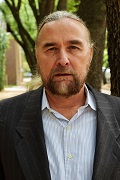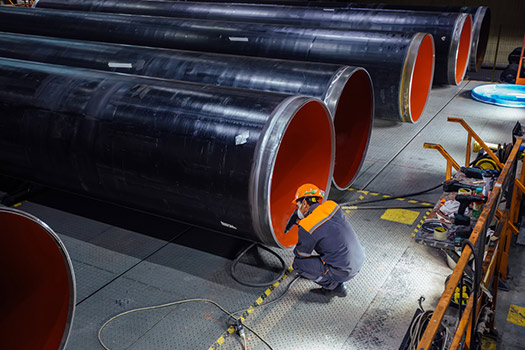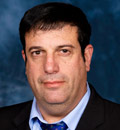September 2023, Vol. 250, No. 9
Guest Perspective
AMPP Chair Looks for Global Outreach

By Michael Reed, Editor-in-Chief
(P&GJ) — In Amir Eliezer’s mind, his path in life has always led him toward practical research, which is where he found his kinship with AMPP and its membership.
The then-future chairman of the AMPP Board of Directors served in the Navy after finishing high school in Israel, but his thirst for knowledge quickly led him to obtain three degrees in materials engineering – up to a Ph.D. and an MBA.
Soon, his education led Eliezer to join a pioneering, practical institute in Israel, which was project-oriented.
“This is where I found AMPP as a source to answer my needs as someone who wanted to know more about corrosion and materials,” he told P&GJ. “Plus, the students were exposed to the bigger picture that the organization presented.”
Eliezer has done research in oil and gas, as well, and is still working with companies in Israel that have succeeded in exploration efforts. Since joining AMPP, he has served as an organization officer.
“If you take business, research, politics and advocacy, this is exactly the mission of AMPP, helping to move us to having a safer society and keeping assets sustainable for the future,” he explained.
Recently, Eliezer spoke with Pipeline & Gas Journal about several topics, including his early attraction to AMPP, training and recruiting the next generation of technical professionals, and his top priorities for his term.
P&GJ: Is the merger between NACE and SSPC to form AMPP progressing as smoothly as the membership had hoped?
Amir Eliezer: The merger was a decision that was supported by nearly 90% of the members who voted. As the only non-U.S. citizen on the transition committee, I know firsthand that it was a serious process that took many months, and everyone was very excited about it.
From the member perspective, most aren’t deep into the details. They understand that there was a merger. They gave feedback, and they backed both SSPC & NACE boards. The actions went smoothly.
AMPP is at an important time because some members may miss the legacy organizations. We need to move forward together to provide AMPP members with the answers to their needs. Today, the majority of members understand that AMPP is one plus one and that’s bigger than two.
P&GJ: What are your top priorities as chairman for the coming year?
Eliezer: My top priorities are within different areas.
Number One – Engaging members abroad and inside the U.S. Bringing back members who were active in the past because they aren’t aware of the new structure. Getting them engaged, whether in their leadership future or their community or overall AMPP activities. Engagement is key.
Number Two – Value. Understanding the members’ needs and focusing on the value for the members because once the members understand the value AMPP brings, then they will be more engaged.
Number Three – Being global. Today, we are comprised of about 60% U.S. and 40% international membership. But the whole idea of creating AMPP was focusing on being global. Global means increasing the activities of our members globally. Education is global. We have huge numbers of certifications – many are global, but they aren’t members. If we can get them engaged, they will see the value in becoming members.
Some see AMPP as a U.S. association, even though we have members in more than 130 countries. I see myself as the first elected AMPP chair with a global voice, opening up for the global society. We need to be globally united.
The AMPP products, especially in oil and gas, can build up careers for young people. They can take a few courses, become certified and then work in the business. But many around the world aren’t aware of AMPP and its offerings. We have amazing tools and a huge potential for growth globally.
Number Four – Leadership. We have an amazing, talented staff, but as a board, we need to work on the strategic future of AMPP, and this is through leadership. Once we are leaders, other leaders will emerge from our committees, courses and even high school programs.
Number Five – Increasing advocacy. We need much more engagement – us as leaders, us at AMPP – with governments within the U.S. and globally.
P&GJ: Is AMPP looking to implement any new services in the near future?
Eliezer: New services can be related to reaching out to more regions, countries and people. We are also looking at our website because people want information in the newest, best and fastest ways. New technologies can fall under new services, even related to oil and gas, because we have much more innovative solutions than 10 or 20 years ago.
We are also always developing industry standards, so watch for new ones related to sustainability initiatives, like carbon capture and alternative fuels.
Our publishing arm has recently launched the first two titles in a series of books focusing on various aspects of bridge maintenance and protection, consisting of valuable legacy technical content. We anticipate many more of these types of publications in the future.
P&GJ: How is AMPP progressing in terms of training and recruiting the next generation of technical professionals?
Eliezer: Overall, AMPP has nearly 80,000 certifications. We are doing a lot in training. We are reaching globally.
The next generation in the field is basically young people or experienced people who are changing careers. Our courses – any age can take a course. Anyone who can work can take AMPP courses. We have nearly 150 courses in our portfolio for people to take.
AMPP is a one-stop shop for the technical professional.
P&GJ: Have your members experienced any difficulty in finding enough qualified workers for the projects they are involved in? Does that differ between the U.S. and other regions?
Eliezer: Today, finding qualified workers is a big problem worldwide. I have talked with members who are also asset owners who say they have a difficult time finding employees and finding employees who will stay long-term with the company.
Today, it’s OK to work for a year or two and move on. So, it’s important to know that out of our 80,000 certification holders, there are qualified people. The big advantage of our industry is that age doesn’t matter.
In the U.S., there is much more recognition that you need qualified workers for projects. In the U.S., they work with standards and QP, so it’s much more valued. Abroad, in many cases, it’s not as necessary for skilled workers or those with certifications to be in charge of projects.
This is where AMPP has huge potential to increase the needs. As we have more skilled workers and as more governments and industries understand working with AMPP standards and inspection programs, there is great potential for growth.
P&GJ: Has the increased cost of any materials of late, coupled with supply chain and lingering Covid complications, affected the amount of work your members are getting?
Eliezer: Worldwide, Covid made a difference. Everything is more expensive today. The big issue – industry is cutting manpower. They believe software or robotics can perform better.
This relates to a previous question about new services. Some of the new services are training people to work with software, sensors, AI and drones within our field.
Just blaming Covid and the supply chain is not the correct reason. The world has changed. We need to deal with it.
P&GJ: What do members view as their biggest challenges over the next couple of years?
Eliezer: People are more worried today. They are more worried about their future.
They are worried about securing work in an industry that is tight. So, the biggest challenge is working in the new world – the new world post-Covid, where people want fast information, where people want things for free, where people no longer want to pay for services or solutions.
Members want to see AMPP grow and see value in their membership so they can do a better job in their careers. Members must keep up with sustainable solutions in the industry, in oil and gas, renewable energy and nano cells.
As long as we live on Earth, we will always have materials and corrosion problems. The concepts and challenges between industries may change, but we are living in a dynamic time.
P&GJ: Do you feel operating companies have stepped up their own efforts to protect their facilities and infrastructure from corrosion in recent years?
Eliezer: Globally, we can do much more. Some companies are pioneers, and we’ve seen those in our own IMPACT Study. But most companies are focused on money rather than maintenance and development.
In my opinion, governments should provide tax refunds or a win-win situation for companies to reinvest in infrastructure. Bottom line, companies are working hard to sustain, and the majority of companies invest just what they can in infrastructure.
P&GJ: How do the primary concerns of members differ in North America vs. Europe and other regions?
Eliezer: Members have similar concerns. Members are members. They are interested in what’s happening at headquarters and what’s going on with the boards. They are interested in the organization’s future and the value of their certification. Because they show concern and give feedback, it shows they are engaged.
And engaging members is one of my missions – listening to them and getting them active in our program committees, task forces and volunteer lists.
P&GJ: What would you say to someone considering delaying or scrimping on corrosion-fighting efforts as a means to tighten their budget?
Eliezer: Cut a little from your overall operation budget because corrosion fighting is not just a word. Nature is aggressive.
People are counting profits. When you only count profits, it can be catastrophic. As we age as an industrial society, if we don’t maintain correctly, we risk everything corroding beneath us. So how we maintain today is part of us taking care of our children, grandchildren, and the future of the world.
In other words, don’t delay or tighten a budget. With smart investing in smart maintenance, a company could save money because the facility could last 20% to 30% longer.







Comments